
Tulipa turkestanica, the Turkestan tulip, is a species of tulip native to Central Asia. It was first described by Eduard August von Regel in 1873 as a variety of T. sylvestris, then elevated to full species status two years later.
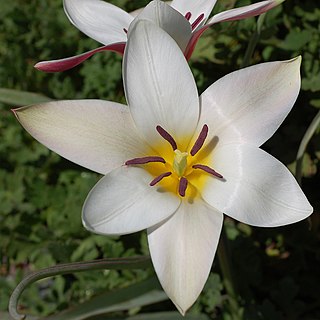
Tulipa clusiana, the lady tulip, is an Asian species of tulip native to Afghanistan, Iran, Iraq, Pakistan and the western Himalayas. It is widely cultivated as an ornamental and is reportedly naturalized in France, Spain, Portugal, Italy, Tunisia, Greece, and Turkey.

Myrtus communis, the common myrtle or true myrtle, is a species of flowering plant in the myrtle family Myrtaceae. It is an evergreen shrub native to southern Europe, North Africa, Western Asia, Macaronesia, and the Indian Subcontinent, and also cultivated.

Scilla nana, known as dwarf glory-of-the-snow, is a bulbous perennial flowering plant endemic to Crete. It flowers in early spring with flowers in shades of lilac blue. After flowering, it goes into dormancy until the next spring. It belongs to a group of Scilla species that were formerly put in a separate genus, Chionodoxa, and may now be treated as Scilla sect. Chionodoxa. It has not always been recognized as distinct from Scilla cretica.

Tulipa urumiensis, the late tulip or tardy tulip, is a species of flowering plant in the family Liliaceae. It is a perennial growing from a bulb. By some sources the accepted name is Tulipa tarda. It has a leathery tunic that is glabrous on the inside. It has up to seven linear green leaves that can be up to 20 cm long. The stem is between 4 and 20 cm long. The yellow flowers have white tips, anthers and stamen are yellow.
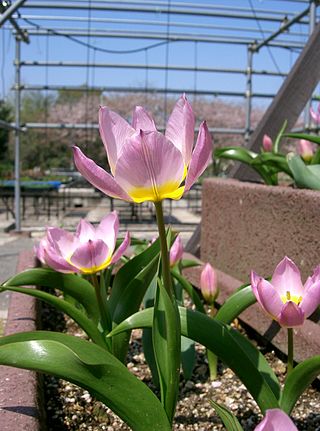
Tulipa saxatilis is a Greek and Turkish species of plant in the genus Tulipa of the family Liliaceae.
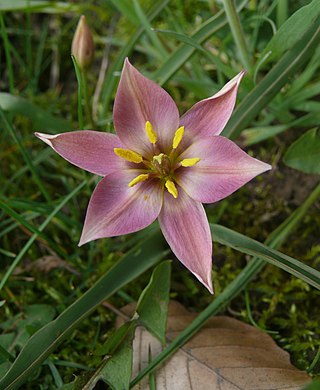
Tulipa humilis is a species of flowering plant in the lily family, found in Syria, Lebanon, Palestine, Turkey, Iran, and the North Caucasus region of Russia. The flowers are pink with yellow centers. Its preferred habitat are rocky mountain slopes. It is known by several other names in horticulture.
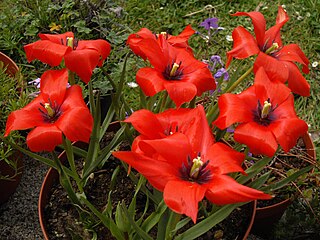
Tulipa linifolia, the flax-leaved tulip or Bokhara tulip, is a species of flowering plant in the tulip genus Tulipa, family Liliaceae, native to Tajikistan, Uzbekistan, northern Iran and Afghanistan. Growing to 20 cm (8 in) tall, it is a bulbous perennial with wavy red-margined sword-shaped leaves, and bowl-shaped red flowers in early to mid-spring. Each petal has blackish marks at the base.
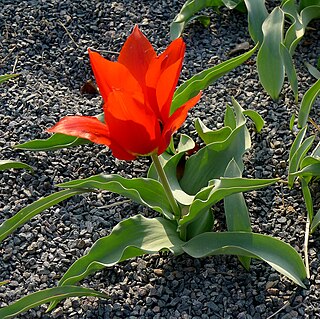
Tulipa eichleri, commonly known as Eichler tulip or Eichler's tulip, is a species of tulip. It is a bulbous flowering perennial with long green leaves,deep red flowers with a central black blotch, coming from the Caucasus Mountains.

Tulipa altaica is a species of tulip found in Russia, Kazakhstan, and China.
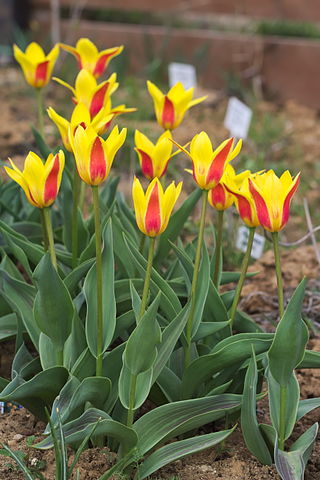
Tulipa kaufmanniana, the water lily tulip, is a species of tulip native to Central Asia.

Tulipa greigii, is a species of tulip native to Central Asia and Iran.

Tulipa praestans is a species of tulip native to the mountains of Tajikistan. Many well known cultivars have been formed from the original plant.

Tulipa kolpakowskiana, or Kolpakowsky's tulip, is a species of tulip native to Afghanistan, Kazakhstan, Kyrgyzstan, and Xinjiang in China. Its petals display a floral iridescence which is perceived by bumblebees. It has gained the Royal Horticultural Society's Award of Garden Merit. Its ultimate height and spread ranges from 0.1 to 0.5 metres and 0 to 0.1 metres, respectively.
Tulipa ferganica is a species of flowering plant in the family Liliaceae, native to Uzbekistan and Kyrgyzstan. It has bright yellow flowers with the three outer petals brushed a brownish-pink, and its slender grey-green leaves have wavy edges. A bulbous geophyte reaching 15 to 25 cm, it is typically found growing on the rocky hillsides surrounding the Fergana Valley. One of the so-called species tulips, it may be available from specialty suppliers.
Tulipa ulophylla is a species of flowering plant in the family Liliaceae. It is native to the Alborz mountains of Iran. A bulbous geophyte, it is found at elevations from 600 to 2,500 m. One of the so-called species tulips, it is not available from commercial suppliers.

Tulipa ingens, the huge tulip, is a species of flowering plant in the family Liliaceae, native to Uzbekistan and Tajikistan. A bulbous geophyte reaching 40 cm (16 in), it is found growing in only 45 to 55 stations at elevations from 1,200 to 2,500 m. The Royal Horticultural Society lists it as a dwarf tulip, stating that it blooms in early spring with black-centered scarlet red flowers.

Tulipa dubia, the Dubian tulip, is a species of flowering plant in the family Liliaceae. It is native to Central Asia, where it is found growing in only 25 to 35 stations. A bulbous geophyte reaching 20 cm (8 in), its yellow flowers have orange markings. It produces a natural hybrid species, Tulipa × tschimganica, with Tulipa kaufmanniana.

Tulipa iliensis, the cowslip-scented tulip, is a species of flowering plant in the family Liliaceae. It is native to Kazakhstan, Kirgizstan, and Xinjiang in China. A bulbous geophyte reaching 20 cm (8 in), it is occasionally available from commercial suppliers.
























